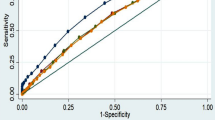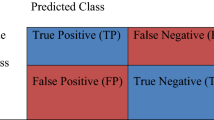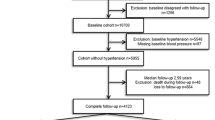Abstract
Hypertension (HTN) is a common chronic condition associated with increased morbidity and mortality. Anthropometric indices of adiposity are known to be associated with a risk of HTN. The aim of this study was to identify the anthropometric indices that best associate with HTN in an Iranian population. 9704 individuals aged 35–65 years were recruited as part of the Mashhad Stroke and Heart Atherosclerotic Disorder (MASHAD) study. Demographic and anthropometric data of all participants were recorded. HTN was defined as a systolic blood pressure (SBP) ≥ 140 mmHg, and/ or a diastolic blood pressure (DBP) ≥ 90 mmHg on two subsequent measurements, or being treated with oral drug therapy for BP. Data mining methods including Logistic Regression (LR), Decision Tree (DT), and Bootstrap Forest (BF) were applied. Of 9704 participants, 3070 had HTN, and 6634 were normotensive. LR showed that body roundness index (BRI), body mass index (BMI) and visceral adiposity index (VAI) were significantly associated with HTN in both genders (P < 0.0001). BRI showed the greatest association with HTN (OR = 1.276, 95%CI = (1.224, 1.330)). For BMI we had OR = 1.063, 95%CI = (1.047, 1.080), for VAI we had OR = 1.029, 95%CI = (1.020, 1.038). An age < 47 years and BRI < 4.04 was associated with a 90% probability of being normotensive. The BF indicated that age, sex and BRI had the most important role in HTN. In summary, among anthropometric indices the most powerful indicator for discriminating hypertensive from normotensive patients was BRI.

This is a preview of subscription content, access via your institution
Access options
Subscribe to this journal
Receive 12 digital issues and online access to articles
$119.00 per year
only $9.92 per issue
Buy this article
- Purchase on Springer Link
- Instant access to full article PDF
Prices may be subject to local taxes which are calculated during checkout



Similar content being viewed by others
References
Lamirault G, Artifoni M, Daniel M, Barber-Chamoux N, Nantes University Hospital Working Group On H. Resistant Hypertension: Novel Insights. Curr Hypertens Rev. 2020;16:61–72.
Tayefi M, Shabani N, Saberi-Karimian M, Oladi M, Mouhebati M, Farjami Z, et al. Systolic and diastolic blood pressure percentiles by age and gender in Northeastern Iran. J Am Soc Hypertension. 2018;12:e85–91.
Mills KT, Stefanescu A, He J. The global epidemiology of hypertension. Nat Rev Nephrol. 2020;16:223–37.
Paudel P, Chalise S, Neupane DR, Adhikari N, Paudel S, Dangi NB. Prevalence of Hypertension in a Community. JNMA J Nepal Med Assoc. 2020;58:1011–7.
James WPT. The epidemiology of obesity: the size of the problem. J Intern Med. 2008;263:336–52.
Wiklund P, Toss F, Weinehall L, Hallmans G, Franks PW, Nordstrom A, et al. Abdominal and gynoid fat mass are associated with cardiovascular risk factors in men and women. J Clin Endocrinol Metab. 2008;93:4360–6.
Engin A. The Definition and Prevalence of Obesity and Metabolic Syndrome. In: Engin A, Engin A, editors. Obesity and Lipotoxicity. Advances in Experimental Medicine and Biology, vol 960. Springer, Cham; 2017. https://doi.org/10.1007/978-3-319-48382-5_1.
Wang C, Fu W, Cao S, Xu H, Tian Q, Gan Y, et al. Association of adiposity indicators with hypertension among Chinese adults. Nutr Metab Cardiovasc Dis. 2021;31:1391–400.
Moosaie F, Fatemi Abhari SM, Deravi N, Karimi Behnagh A, Esteghamati S, Dehghani Firouzabadi F, et al. Waist-to-height ratio is a more accurate tool for predicting hypertension than waist-to-hip circumference and BMI in patients with type 2 diabetes: a prospective study. Front Public Health. 2021;9:726288.
Calderón-García JF, Roncero-Martín R, Rico-Martín S, De Nicolás-Jiménez JM, López-Espuela F, Santano-Mogena E, et al. Effectiveness of body roundness index (BRI) and a body shape index (ABSI) in predicting hypertension: a systematic review and meta-analysis of observational studies. Int J Environ Res Public Health. 2021;18:11607.
Abolhasani M, Maghbouli N, Karbalai Saleh S, Aghsaeifar Z, Sazgara F, Tahmasebi M, et al. Which anthropometric and metabolic index is superior in hypertension prediction among overweight/obese adults? Integr Blood Press Control. 2021;14:153–61.
Liu Y, Sun G, Li Y. A prospective cohort study on the association of lean body mass estimated by mid-upper arm muscle circumference with hypertension risk in Chinese residents. J Clin Hypertens. 2022;24:329–38.
Mansoori A, Farizani Gohari NS, Etemad L, Poudineh M, Ahari RK, Mohammadyari F, et al. White blood cell and platelet distribution widths are associated with hypertension: data mining approaches. Hypertens Res. 2023. https://doi.org/10.1038/s41440-023-01472-y. Epub ahead of print.
Chaikijurajai T, Laffin LJ, Tang WHW. Artificial intelligence and hypertension: recent advances and future outlook. Am J Hypertens. 2020;33:967–74.
Chang W, Liu Y, Xiao Y, Yuan X, Xu X, Zhang S, et al. A machine-learning-based prediction method for hypertension outcomes based on medical data. Diagnostics. 2019;9:178.
Leha A, Hellenkamp K, Unsöld B, Mushemi-Blake S, Shah AM, Hasenfuß G, et al. A machine learning approach for the prediction of pulmonary hypertension. PLoS One. 2019;14:e0224453.
Ghayour-Mobarhan M, Moohebati M, Esmaily H, Ebrahimi M, Parizadeh SM, Heidari-Bakavoli AR, et al. Mashhad stroke and heart atherosclerotic disorder (MASHAD) study: design, baseline characteristics and 10-year cardiovascular risk estimation. Int J Public Health. 2015;60:561–72.
Muntner P, Shimbo D, Carey RM, Charleston JB, Gaillard T, Misra S, et al. Measurement of blood pressure in humans: a scientific statement from the American Heart Association. Hypertension 2019;73:e35–66.
American Diabetes Association. 2. Classification and diagnosis of diabetes: standards of medical care in diabetes-2018. Diabetes Care. 2018;41:S13–s27.
World Health Organization. Regional Office for the Western P. The Asia-Pacific perspective : redefining obesity and its treatment. Sydney: Health Communications Australia; 2000.
Ashwell M, Gibson S. Waist to height ratio is a simple and effective obesity screening tool for cardiovascular risk factors: analysis of data from the British National Diet And Nutrition Survey of adults aged 19-64 years. Obes Facts. 2009;2:97–103.
Thomas DM, Bredlau C, Bosy‐Westphal A, Mueller M, Shen W, Gallagher D, et al. Relationships between body roundness with body fat and visceral adipose tissue emerging from a new geometrical model. Obesity. 2013;21:2264–71.
Bergman RN, Stefanovski D, Buchanan TA, Sumner AE, Reynolds JC, Sebring NG, et al. A better index of body adiposity. Obesity (Silver Spring). 2011;19:1083–9. https://doi.org/10.1038/oby.2011.38. Epub 2011 Mar 3.
Krakauer NY, Krakauer JC. A new body shape index predicts mortality hazard independently of body mass index. PloS one. 2012;7:e39504.
David W, Hosmer Jr. SL, Rodney X. Sturdivant. Applied logistic regression. 3rd, editor. Hoboken, New Jersey: John Wiley & Sons, Inc.; 2013.
Hooley JM, Teasdale JD. Predictors of relapse in unipolar depressives: expressed emotion, marital distress, and perceived criticism. J Abnorm Psychol. 1989;98:229.
Mohammadi F, Pourzamani H, Karimi H, Mohammadi M, Mohammadi M, Ardalan N, et al. Artificial neural network and logistic regression modelling to characterize COVID-19 infected patients in local areas of Iran. Biomed J. 2021;44:304–16.
Zhong Y, editor. The analysis of cases based on decision tree. In: 2016 7th IEEE international conference on software engineering and service science (ICSESS). Beijing, China: IEEE; 2016.
Aghasizadeh M, Samadi S, Sahebkar A, Miri‐Moghaddam E, Esmaily H, Souktanloo M, et al. Serum HDL cholesterol uptake capacity in subjects from the MASHAD cohort study: Its value in determining the risk of cardiovascular endpoints. J Clin Lab Anal. 2021;35:e23770.
Saberi‐Karimian M, Safarian‐Bana H, Mohammadzadeh E, Kazemi T, Mansoori A, Ghazizadeh H, et al. A pilot study of the effects of crocin on high‐density lipoprotein cholesterol uptake capacity in patients with metabolic syndrome: a randomized clinical trial. BioFactors 2021;47:1032–41.
Mansoori A, Sahranavard T, Hosseini ZS, Soflaei SS, Emrani N, Nazar E, et al. Prediction of type 2 diabetes mellitus using hematological factors based on machine learning approaches: a cohort study analysis. Sci Rep. 2023;13:1–11.
Saberi‐Karimian M, Mansoori A, Bajgiran MM, Hosseini ZS, Kiyoumarsioskouei A, Rad ES, et al. Data mining approaches for type 2 diabetes mellitus prediction using anthropometric measurements. J Clin Lab Anal. 2023;37:e24798.
Ghazizadeh H, Shakour N, Ghoflchi S, Mansoori A, Saberi-Karimiam M, Rashidmayvan M, et al. Use of data mining approaches to explore the association between type 2 diabetes mellitus with SARS-CoV-2. BMC Pulm Med. 2023;23:1–14.
Mansoori A, Hosseini ZS, Ahari RK, Poudineh M, Rad ES, Zo MM, et al. Development of data mining algorithms for identifying the best anthropometric predictors for cardiovascular disease: MASHAD cohort study. High Blood Press Cardiovasc Prev 2023;30:243–53.
Wang H, Tang J, Wu M, Wang X, Zhang T. Application of machine learning missing data imputation techniques in clinical decision making: taking the discharge assessment of patients with spontaneous supratentorial intracerebral hemorrhage as an example. BMC Med Inform Decis Mak. 2022;22:1–14.
Mohammadi M, Mansoori A. A projection neural network for identifying copy number variants. IEEE J Biomed health Inform. 2018;23:2182–8.
Saberi-Karimian M, Khorasanchi Z, Ghazizadeh H, Tayefi M, Saffar S, Ferns GA, et al. Potential value and impact of data mining and machine learning in clinical diagnostics. Crit Rev Clin Lab Sci. 2021;58:275–96.
Yang J, Wang F, Han X, Yuan J, Yao P, Liang Y, et al. Different anthropometric indices and incident risk of hypertension in elderly population: a prospective cohort study. Zhonghua Yu Fang Yi Xue Za Zhi. 2019;53:272–8.
Khanna D, Rehman A. Pathophysiology of obesity. StatPearls. Treasure Island (FL): StatPearls Publishing LLC.; 2022.
Zhang Z, Shi D, Zhang Q, Wang S, Liu K, Meng Q, et al. Visceral adiposity index (VAI), a powerful predictor of incident hypertension in prehypertensives. Intern Emerg Med. 2018;13:509–16.
Gómez-Ambrosi J, Silva C, Galofré J, Escalada J, Santos S, Millán D, et al. Body mass index classification misses subjects with increased cardiometabolic risk factors related to elevated adiposity. Int J Obes. 2012;36:286–94.
Rothman KJ. BMI-related errors in the measurement of obesity. Int J Obes. 2008;32:S56–9.
Bigaard J, Frederiksen K, Tjønneland A, Thomsen BL, Overvad K, Heitmann BL, et al. Body fat and fat‐free mass and all‐cause mortality. Obes Res. 2004;12:1042–9.
Li M, Lin J, Liang S, Huang S, Wen Z, Mo Z. Predicted fat mass, lean body mass, and risk of hypertension: results from a Chinese male cohort study. Obes Facts. 2022;15:638–47.
Amato MC, Giordano C. Visceral adiposity index: an indicator of adipose tissue dysfunction. Int J Endocrinol. 2014;2014:730827.
Rezende AC, Souza LG, Jardim TV, Perillo NB, Araújo YCL, de Souza SG, et al. Is waist-to-height ratio the best predictive indicator of hypertension incidence? A cohort study. BMC Public Health. 2018;18:1–11.
Fan Y, He D, Liu S, Qiao Y, Gao H, Xin L. Association between visceral adipose index and risk of hypertension in a middle-aged and elderly Chinese population. Nutr, Metab Cardiovascular Dis. 2021;31:2358–65.
Yang J, Li H, Han L, Zhang L, Zhou Y. Association between Visceral Adiposity Index and hypertension among Chinese Adults: a nationwide cross-sectional study in the China Health and Nutrition Survey. Blood Press Monit. 2020;25:271–7.
Choi J, Ahn S, Kim J, Koh S, Choi E, Lee G, et al. Comparison of various anthropometric indices for the identification of a predictor of incident hypertension: the ARIRANG study. J Hum Hypertens. 2018;32:294–300.
Deng G, Yin L, Liu W, Liu X, Xiang Q, Qian Z, et al. Associations of anthropometric adiposity indexes with hypertension risk: a systematic review and meta-analysis including PURE-China. Medicine. 2018;97:e13262.
Barbosa AR, Munaretti DB, Da Silva Coqueiro R, Borgatto AF. Anthropometric indexes of obesity and hypertension in elderly from Cuba and Barbados. J Nutr Health Aging. 2011;15:17–21.
Kim B, Park J, Ahn Y, Kimm K, Shin C. Geographical difference in the prevalence of isolated systolic hypertension in middle-aged men and women in Korea: the Korean Health and Genome Study. J Hum Hypertens. 2005;19:877–83.
Sakurai M, Miura K, Takamura T, Ota T, Ishizaki M, Morikawa Y, et al. Gender differences in the association between anthropometric indices of obesity and blood pressure in Japanese. Hypertens Res. 2006;29:75–80.
Jayedi A, Soltani S, Zargar MS, Khan TA, Shab-Bidar S. Central fatness and risk of all cause mortality: systematic review and dose-response meta-analysis of 72 prospective cohort studies. BMJ. 2020;370:m3324.
Lu N, Wang R, Ji M, Liu X, Qiang L, Ma C, et al. The value of hip circumference/height(x) ratio for identifying childhood hypertension. Sci Rep. 2018;8:3236.
Colafella KMM, Denton KM. Sex-specific differences in hypertension and associated cardiovascular disease. Nat Rev Nephrol. 2018;14:185–201.
Mozaffarian D, Benjamin EJ, Go AS, Arnett DK, Blaha MJ, Cushman M, et al. Heart disease and stroke statistics-2015 update: a report from the American Heart Association. Circulation. 2015;131:e29–322.
Gurven M, Blackwell AD, Rodríguez DE, Stieglitz J, Kaplan H. Does blood pressure inevitably rise with age? Longitudinal evidence among forager-horticulturalists. Hypertension. 2012;60:25–33.
Chang C-D, Wang C-C, Jiang BC. Using data mining techniques for multi-diseases prediction modeling of hypertension and hyperlipidemia by common risk factors. Expert Syst Appl. 2011;38:5507–13.
Zhao H, Zhang X, Xu Y, Gao L, Ma Z, Sun Y, et al. Predicting the risk of hypertension based on several easy-to-collect risk factors: a machine learning method. Front Public Health. 2021;9:619429.
Wang Z, Chen Z, Zhang L, Wang X, Hao G, Zhang Z, et al. Status of hypertension in China: results from the China hypertension survey, 2012–2015. Circulation. 2018;137:2344–56.
Author information
Authors and Affiliations
Contributions
AM: conception, data analyzing. NS: conception, drafting the article. RV: revising the article. FH: drafting the article. MHM: drafting the article. MH: revising the article. MP: drafting the article. GF: revising the article. HE: corresponding author. MG-M: corresponding author.
Corresponding authors
Ethics declarations
Competing interests
The authors declare no competing interests.
Ethics approval
This study protocol was reviewed and approved by the Ethics Committee of MUMS, approval number IR.MUMS.REC.1386.250.
Additional information
Publisher’s note Springer Nature remains neutral with regard to jurisdictional claims in published maps and institutional affiliations.
Rights and permissions
Springer Nature or its licensor (e.g. a society or other partner) holds exclusive rights to this article under a publishing agreement with the author(s) or other rightsholder(s); author self-archiving of the accepted manuscript version of this article is solely governed by the terms of such publishing agreement and applicable law.
About this article
Cite this article
Mansoori, A., Seifi, N., Vahabzadeh, R. et al. The relationship between anthropometric indices and the presence of hypertension in an Iranian population sample using data mining algorithms. J Hum Hypertens 38, 277–285 (2024). https://doi.org/10.1038/s41371-023-00877-z
Received:
Revised:
Accepted:
Published:
Issue Date:
DOI: https://doi.org/10.1038/s41371-023-00877-z



